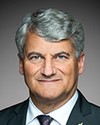I will make a comment and talk about three historical events that are quite relevant to what you just said.
Legally, everything stays the same. It is not necessary to introduce additional mechanisms. Legally, Mr. Charest was premier until the day Ms. Marois was sworn in. Therefore absolutely nothing changed.
I would like to refer to three historical events that are relevant here.
First, in 1979, during the federal election, the Liberal Party won more votes than the Conservative Party, but Mr. Trudeau Sr. announced that even though he had more votes, he was ceding power to the Conservative Party because more Conservative MPs had been elected to the House of Commons at the time.
I see that I'm running out of time, but this is worth saying.
Second, in 1966, at the provincial level, Jean Lesage's Liberal Party obtained 46% of the votes while the Union Nationale Party of Daniel Johnson Sr. obtained 40%; however, more Union Nationale members were elected. Mr. Lesage chose to ignore the whole thing. In a live interview conducted by Pierre Nadeau, Daniel Johnson Sr. made a colourful statement. He said: “Mr. Lesage might not know that he lost, but we certainly know that we won.”
To conclude, it's not the plurality of votes, but rather the total number of elected members that determines who forms government.

